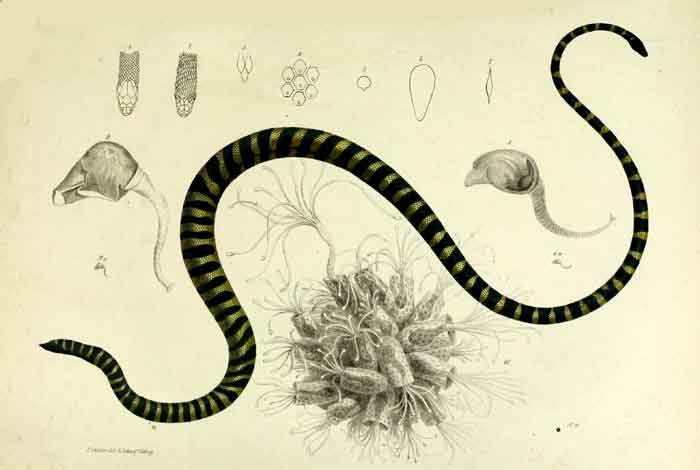
Superregnum: Eukaryota
Cladus: Unikonta
Cladus: Opisthokonta
Cladus: Holozoa
Regnum: Animalia
Subregnum: Eumetazoa
Cladus: Bilateria
Cladus: Nephrozoa
Superphylum: Deuterostomia
Phylum: Chordata
Subphylum: Vertebrata
Infraphylum: Gnathostomata
Megaclassis: Osteichthyes
Cladus: Sarcopterygii
Cladus: Rhipidistia
Cladus: Tetrapodomorpha
Cladus: Eotetrapodiformes
Cladus: Elpistostegalia
Superclassis: Tetrapoda
Cladus: Reptiliomorpha
Cladus: Amniota
Classis: Reptilia
Cladus: Eureptilia
Cladus: Romeriida
Subclassis: Diapsida
Cladus: Sauria
Infraclassis: Lepidosauromorpha
Superordo: Lepidosauria
Ordo: Squamata
Cladus: Unidentata, Episquamata
Cladus: Toxicofera
Subordo: Serpentes
Infraordo: Caenophidia
Superfamilia: Elapoidea
Familia: Elapidae
Subfamilia: Hydrophiinae
Genus: Hydrophis
Species: Hydrophis gracilis
Name
Hydrophis gracilis (Shaw, 1802)
References
Links
Uetz, P. & Hallermann, J. 2024. Hydrophis gracilis. The Reptile Database. Accessed on 2 June 2021.
Guinea, M., Sanders, K. & Lobo, A. 2010. IUCN: Hydrophis gracilis (Least Concern). The IUCN Red List of Threatened Species 2010: e.T176765A7299914. DOI: 10.2305/IUCN.UK.2010-4.RLTS.T176765A7299914.en
Vernacular names
English: Graceful Small-headed Sea Snake
Microcephalophis gracilis, also known as the graceful small-headed seasnake, slender sea snake, narrow-headed sea snake, common small-headed sea snake, is a species of sea snake found in the Indian and Pacific Oceans.[1][2][3] It is venomous.[2][3]
Diagnostic characters
Head small, body long and slender anteriorly; scales on thickest part of body juxtaposed; 5–6 maxillary teeth behind fangs; 17–21 scale rows around neck, 30–36 around thickest part of body (increase from neck to midbody 18–24); ventrals divided by a longitudinal fissure; prefrontal in contact with third upper labial; ventrals 220–287.[2][4]
Total length males 950 mm, females 1025 mm; tail length males 80 mm, females 95 mm.[2][4]
Distribution
Microcephalophis gracilis is found on the coasts of the Indian Ocean and West Pacific, from around the Persian Gulf (Bahrain, Qatar, Saudi Arabia, Oman, United Arab Emirates (UAE), Iran, Iraq and Kuwait) to Pakistan, India, Sri Lanka, Bangladesh, Myanmar, Thailand, and Indonesia, and into the Malay Archipelago/West Pacific in Thailand, Malaysia, Singapore, Cambodia, Vietnam, the Philippines, southern China, Hong Kong, and Taiwan, as well as in Australia (Queensland) and Papua New Guinea.[1][4]
Venom Characteristics
The venom of this species is dangerous and can be fatal. The symptoms generally began to appear within 30 minutes after being bitten. The bite typically does not cause any pain. Muscles get affected once the venom starts to act causing paralysis which is one of the major characteristics of its bite. Victim may also experience headache, thirst and sweating after the bite.
References
Guinea, M.; Sanders, K.; Lobo, A. (2010). "Hydrophis gracilis". IUCN Red List of Threatened Species. 2010: e.T176765A7299914. doi:10.2305/IUCN.UK.2010-4.RLTS.T176765A7299914.en. Retrieved 24 October 2022.
Microcephalophis gracilis at the Reptarium.cz Reptile Database. Accessed 24 October 2022.
"Hydrophis gracilis". WCH Clinical Toxinology Resources. 2001–2018. Retrieved 24 October 2022.
Leviton, A.E.; Wogan, G.O.U.; Koo, M.S.; Zug, G.R.; Lucas, R.S. & Vindum, J.V. (2003). "The Dangerously Venomous Snakes of Myanmar. Illustrated Checklist with Keys" (PDF). Proceedings of the California Academy of Sciences. 54 (24): 407–462.
Retrieved from "http://en.wikipedia.org/"
All text is available under the terms of the GNU Free Documentation License

